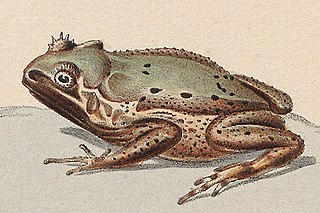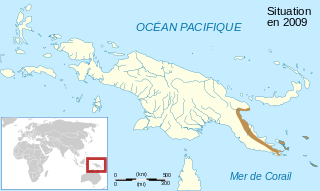
Asterophrys is a genus of microhylid frogs found in New Guinea. Their common name is New Guinea bush frogs, although this name may also specifically refer to Asterophrys turpicola.

Barbourula busuangensis is a species of frog in the family Bombinatoridae. It is also known under the common names Philippine flat-headed frog, Palawan flat-headed frog, Busuanga jungle toad, Busuanga disk-tongued toad, and Philippine aquatic frog. It is endemic to the Busuanga, Culion, Balabac, and Palawan islands in the Philippines. It is an inhabitant of clear-water streams and is threatened by habitat loss.
Asterophrys leucopus is a species of frog in the family Microhylidae. It is endemic to northwestern Papua New Guinea where it is known from three locations: Stolle Mountain in the Sandaun Province—its type locality, and Hunstein Mountains in the East Sepik Province and the Bewani Mountains in the West Sepik Province.
Austrochaperina adamantina is a species of frog in the family Microhylidae. It is endemic to New Guinea and occurs in the Torricelli and Bewani Mountains in the West Sepik Province, Papua New Guinea. The specific name adamantina is Latin for "like a diamond" and refers to Jared Diamond, credited as the collector of the holotype and "great many other valuable herpetological specimens from Papua New Guinea".

Barygenys atra is a species of frog in the family Microhylidae. It is endemic to eastern New Guinea and is known from the Morobe and Northern Provinces, Papua New Guinea. Common name Gunther's Papua frog has been proposed for it.

Breviceps adspersus, also known as common rain frog, bushveld rain frog, and many other vernacular names, is a species of frog in the family Brevicipitidae. It is found in Southern Africa, in Angola, Namibia, Botswana, Zambia, Zimbabwe, South Africa, Eswatini, and Mozambique.

Callulops personatus is a species of frog in the family Microhylidae. It is endemic to the northern lowlands of central New Guinea and occurs in both Western New Guinea (Indonesia) and Papua New Guinea. The specific name personatus is Latin adjective meaning "masked", in reference to the head coloration. Common name Maprik callulops frog has been proposed for it.

Callulops stictogaster is a species of frog in the family Microhylidae. It is endemic to New Guinea and occurs in the central mountain ranges of Papua New Guinea in the Western Highlands, Eastern Highlands, Chimbu, and Morobe Provinces. The specific name stictogaster is derived from the Greek stictos (="spotted") and gaster (="belly"). Common name Irumbofoie callulops frog has been proposed for it.

Callulops wilhelmanus is a species of frog in the family Microhylidae. It is endemic to the central mountain ranges of Papua New Guinea. Its natural habitats are dense, primary montane rainforest at elevations of 2,230–3,400 m (7,320–11,150 ft) above sea level. It lives on the forest floor. It can also adapt to live in degraded habitats, including rural gardens. It can be locally abundant although it does not typically occur at high densities.

Choerophryne rostellifer, also known as the Torricelli Mountain frog, is a species of frog in the family Microhylidae. It is endemic to New Guinea and currently only known from Papua New Guinea, with records from the coastal ranges in the north, between the Adelbert Range in the east and the Bewani Mountains in the west, and further southward to the Star Mountains. Some records are from close to the Indonesian border, and it is probable that this species is to be found also in Western New Guinea.
Cophixalus verecundus is a species of frog in the family Microhylidae. It is endemic to New Guinea in Papua New Guinea, where it is only known around Mt. Bellamy in Owen Stanley Mountains though it may more widely distributed.

Sphenophryne thomsoni, sometimes known as Thomson's toothless frog, is a species of frog in the family Microhylidae. It is endemic to Papua New Guinea and occurs in the southeastern peninsular New Guinea, Louisiade Archipelago, d'Entrecasteaux Islands, and Woodlark Island. It was formerly in its own monotypic genus Genyophryne. The specific name thomsoni honours Basil Thomson, a British intelligence officer, police officer, prison governor, colonial administrator, and writer.
Oreophryne biroi is a species of frog in the family Microhylidae. It is endemic to New Guinea and occurs on the north coast from Madang Province in Papua New Guinea to the Cyclops Mountains in Papua province, Western New Guinea (Indonesia). The specific name biroi honours Lajos Bíró, a Hungarian zoologist and ethnographer who collected the holotype. Common name New Guinea cross frog has been coined for it.
Mantophryne menziesi, commonly known as the Iarowari School frog, is a species of frog in the family Microhylidae. It is endemic to New Guinea and is only known from near Port Moresby, Papua New Guinea. The actual limits of its distribution are poorly known.

Sphenophryne cornuta is a species of frogs in the family Microhylidae. It is endemic to New Guinea where it is widespread and found both in the Western New Guinea (Indonesia) and Papua New Guinea. Common name horned land frog has been proposed for it.
Xenorhina zweifeli is a species of frog in the family Microhylidae. It is endemic to New Guinea and is only known from the Bewani and Hunstein Mountains in northern Papua New Guinea. The species is named for American herpetologist Richard G. Zweifel, a specialist in New Guinean herpetology and microhylid frogs; he is also said to share "characteristically terse vocalizations" with this frog.
Cornufer acrochordus, also known as the Bougainville wrinkled ground frog, is a species of frog in the family Ceratobatrachidae. It is endemic to the Solomon Islands archipelago and occurs on Bougainville, Choiseul, and Santa Isabel Islands, although its distribution in the archipelago is not properly known. The specific name acrochordus is Greek for "warty" and refers to the warty skin of this species.
Cornufer macrosceles is a species of frog in the family Ceratobatrachidae. It is endemic to the island of New Britain, Papua New Guinea. It is only known from the Nakanai Mountains in the central part of the island. Only three specimens are known. Common name Ti wrinkled ground frog has been coined for the species.

The spiny tree frog is a species of frog in the family Rhacophoridae. It is endemic to the Philippines and occurs on Mindanao, Leyte, Bohol, and Basilan, possibly wider.
Asterophrys pullifer is a species of frog in the family Microhylidae. It is endemic to New Guinea and known from the Wondiwoi Mountains at the base of the Wandammen Peninsula in Western New Guinea (Indonesia), and from the Mount Shungol and Bowutu Mountains in Papua New Guinea.











